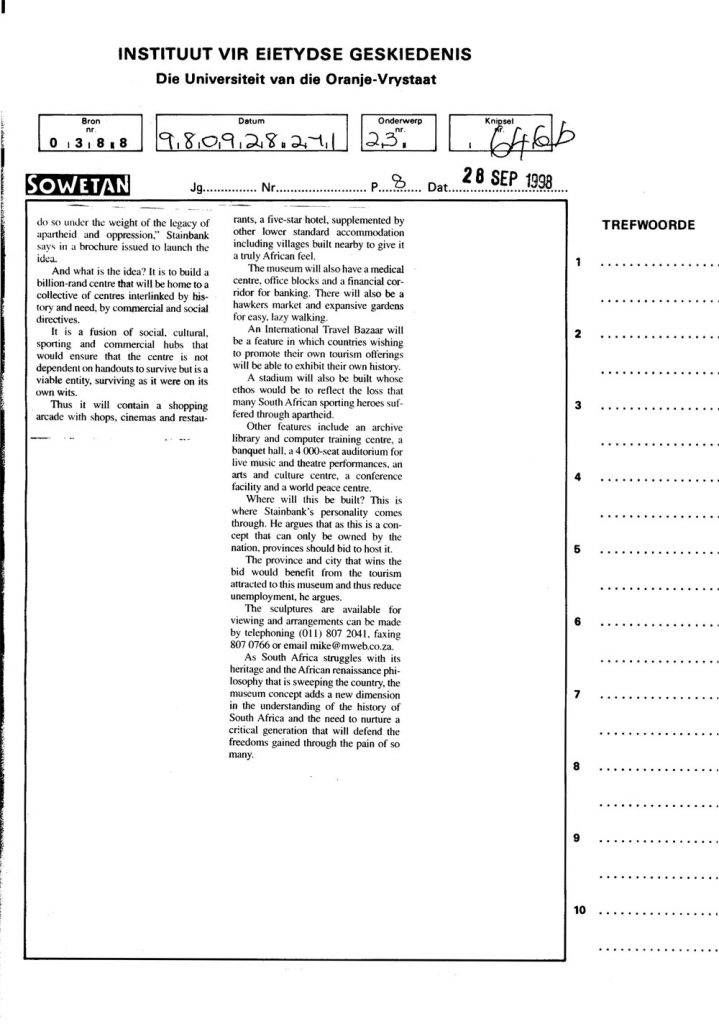Written by Mathatha Tsedu – SOWETAN 28 September 1998

It is just another house in Rivonia, Johannesburg. Automated gates, spacious lawns, and a well-built house set to the back of the plot. But step inside and you find a reception area decorated with African artefacts, paintings of African scenes and carvings. In the rooms beyond, a buzz of activity as this house-turned-into-an-office goes about its chores.
Down the passage, a door opens to a darkened room. As the dimmer light switch is turned on, the impact of its contents hits one in the face, leaving one gasping. Nelson Mandela, Robert Mangaliso Sobukwe, Steve Biko, Chris Hani and Desmond Tutu sit side by side in sculptures that in their own way tell the story of their persona. In between or was it on one side, is the sculpture of the scene that has come to represent the uprising of 1976, a limp body in the hands of an angry bigger brother, blood oozing out of the limp body as a sister screams as she runs alongside the boy. But in this sculpture, the woman, in the school uniform, raises her fist, defying death, telling the killers as it were that the struggle continues. In another corner is a woman, her face a blank slate, baby strapped to the back, one hand on her chest, and her fist high in the air in the salute that has since time immemorial represented power and defiance. It is not possible to stand there and but wonder and be awed by what that room represents. It is a monument of struggle and reminder of times past and present. It is in this room that the genesis of what has now come to be called The Apartheid Museum was born. Mike Stainbank, owner of the registered trademark, and originator of the concept, has been nursing the idea for over twenty years and says it is a museum of “our past, and a monument to our future, because it is only after lancing the abscess of colonialism and apartheid that we can understand the effect it has had on our lives” “Only then can we look towards healing, towards unifying our nation”.
But it is not the house that Stainbank wants to turn into a Museum. He wants it to be built in a billion-rand project which would be a “Vibrant, social, cultural, sporting and commercial concourse where our history is told interactively” Stainbank argues that the “tragedy of apartheid begs the South African Nation to take a strong position on lessons for humanity.
“The central concern is that we must realise that the healing and fulfillment that comes with it, can only be achieved by ourselves. We cannot view history at arms-length. We must look at our pain, examine it and process its’ effect on our lives.”
“The Apartheid Museum can and must serve to bring psychological peace to all those who suffered and continue to do so under the weight of the legacy of apartheid and oppression, Stainbank says in a brochure issued to launch the idea.
And what is the idea? It is to build a billion rand centre that will be home to a collective of centres interlinked by history and need, by commercial and social directives. It is a fusion of social-cultural sporting and commercial hubs that will ensure that the centre is not dependent on handouts to survive but is a viable entity surviving as it were on its own wits. Thus it will contain a shopping arcade with shops, cinemas and restaurants, a five-star hotel, supplemented by other lower standard accommodation including villages built nearby to give it a truly African feel. The museum will also have a medical centre, office blocks a financial corridor for banking. There will also be a hawkers market and expansive gardens for easy lazy walking.
An international travel bazaar will be feature in which countries wishing to promote their own tourism offerings will be able to exhibit their own history. A stadium will also be built whose ethos will be to reflect the loss that many South African sporting heroes suffered through apartheid. Other features include an archive library and computer training centre, a banquet hall, a 4000-seat auditorium for live music and theatre performances, an arts and culture centre, a conference facility and a World Peace Centre.
Where will this be built? This is where Stainbank’s personality comes through. He argues that as this is concept that can only be owned the nation, provinces should bid to host it. The province and city that wins the bid would benefit from the tourism attracted to this museum and thus reduce unemployment, he argues.
As South Africa struggles with its heritage and the African renaissance philosophy that is sweeping the country, the museum concept adds a new dimension in the understanding of the history of South Africa and the need to nurture a critical generation that will defend the freedoms gained through the pains of so many.
=================
ORIGINAL NEWSPAPER CLIPPING OF THE ARTICLE FROM THE SOWETAN:








